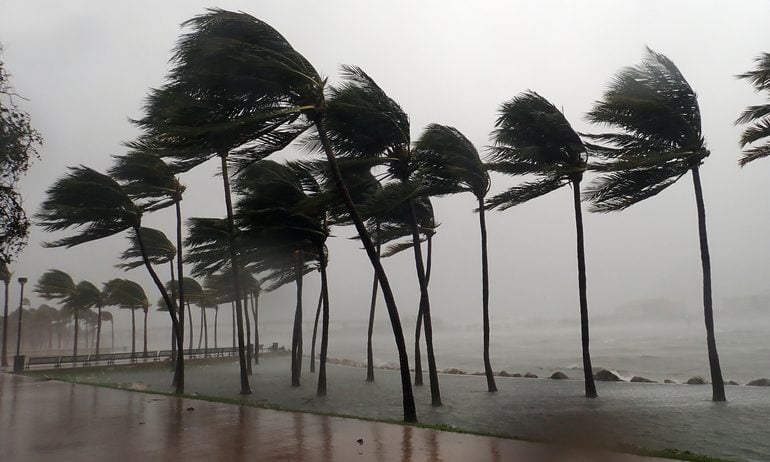7 Tips to Prepare Your House for Hurricane Season
This year’s hurricane season could bring over a dozen hurricanes to U.S. coasts — is your home ready for the wind and rain?

Some or all of the mortgage lenders featured on our site are advertising partners of NerdWallet, but this does not influence our evaluations, lender star ratings or the order in which lenders are listed on the page. Our opinions are our own. Here is a list of our partners.
This year's Atlantic hurricane season might be one for the books. The National Oceanic and Atmospheric Administration (NOAA) forecasts up to 13 hurricanes between June 1 and Nov. 30, with as many as seven reaching at least Category 3 status. If the prediction is accurate, this year will be one of the most active Atlantic hurricane seasons on record.
For coastal homeowners, this could mean home damage — even if they live inland.
“You can still see wind damage, even if you’re not experiencing those maximum winds,” says Sarah Dillingham, senior meteorologist at the Insurance Institute for Business and Home Safety, which researches structure safety. With slower-moving storms, homeowners who live farther inland might have roof and soffit damage or lose some trees, Dillingham says.
Many homeowners who live in hurricane zones tend to wait until a storm is tracking toward them to get ready, but that can cause expensive mistakes.
“Being well-prepared for hurricane season is a process that takes time and thought,” says Mellanee Roberts, deputy emergency management coordinator for the City of Pearland in Texas, by email.
Here are seven tips to put you ahead of the weather.
1. Trim or remove trees near your home
“Homeowners should be sure to trim away any tree branches and landscaping that would hit the house in heavy wind,” Roberts said.
According to NOAA, a Category 1 hurricane (the weakest category) is strong enough to break large tree branches. When combined with rain-saturated soil, the winds can also uproot entire trees.
Branches that are weak or dead are the most vulnerable to high winds and can take out your roof or guttering on their way down.
Signs that a tree is in bad shape may include cracking in the trunk, loss of leaves before the appropriate season, abnormally soft roots or a hollow sound when knocking on the trunk.
If you need help removing large branches or taking down an entire tree, Dillingham says, consider calling a licensed arborist.
2. Look for loose or damaged fence boards
Winds over 39 mph are enough to turn items into projectiles, according to the National Weather Service. That means loose or damaged fence boards will be more susceptible to high winds than their secured counterparts.
To give your fence its best chance, fix or replace pieces that won’t stay attached or that show signs of damage.
Securing your fence can also protect your home. If fencing comes loose during a hurricane, the boards can become projectiles that hit your house. By ensuring your fence is prepared for high winds, you are also reducing the chance that storm debris will damage your home.
3. Inspect your roof for loose or damaged shingles
Your roof takes the brunt of hurricane winds, which can exceed 157 mph, according to the National Weather Service. That can lead to missing shingles or tiles, holes from debris and damage where the wind rips away solar panels, satellite dishes or other attachments.
If you see sections of your roof that are discolored after rain, loose or damaged shingles, loose or bent flashing that connects your chimney to the shingles, or cracked vents, it might be time to call in a professional.
Leaks in your attic after a heavy storm are also a sign that your roof could use some professional attention.
4. Clean out your gutters
Slow-moving hurricanes that sit over areas for a long time can dump several inches of rain an hour, as Hurricane Harvey did in Texas in 2017. That means gutters need to be ready to divert the water.
“Making sure that that water can easily be transported off your roof and away from your home — that’s going to be helpful,” Dillingham says.
Removing debris from your gutters will allow water to drain quickly from your roof, and clearing out downspouts will help it flow away from your home, Dillingham says. Also look for signs of damage, such as cracks or loose sections, and call a gutter company for a repair if you notice any potential problems.
5. Check your windows and doors
Hurricane-force winds can drive rain into your home through small gaps in windows and doors.
“If you’ve got a vulnerable opening, your water’s going to try to find a way in,” Dillingham says.
For windows and doors, check that the flashing — a strip of special material installed around the exterior of the openings — isn’t damaged or pulling away from the house. Look for spots where sunlight is coming through and close them with weatherstripping. Add caulking to fill spots along the windowsill that have worn away, Dillingham says.
Dillingham also recommends paying special attention to access points that open inward, such as French doors, which can fail more easily in high winds.
6. Clean out space in your garage
Although bringing loose items indoors is essential before a hurricane arrives — think of all the YouTube videos of trampolines going airborne, Dillingham says — many homeowners don’t think of this step until a storm is on its way.
To get a head start, set aside space now in your garage or shed to store patio furniture, yard decor and kids’ toys so you can quickly clear your property.
Not only does this make things easier when a hurricane is on its way, but also you’ll have space to store items during other weather events, such as strong thunderstorms (and you won't have to buy another trampoline).
7. Don’t forget the insurance
Learn about the flood risks in your area, even if you don’t think you’re in a floodplain. Make sure you have sufficient insurance coverage to cover hurricane damage.
“Homeowners insurance is not going to cover any losses from storm surge or inland flooding due to rainfall,” Dillingham says. Also, don’t count on a home warranty to help with repairs after a hurricane. Most plans don’t cover any damage related to wind, rain, floods or fire. That includes roof damage from strong winds.



